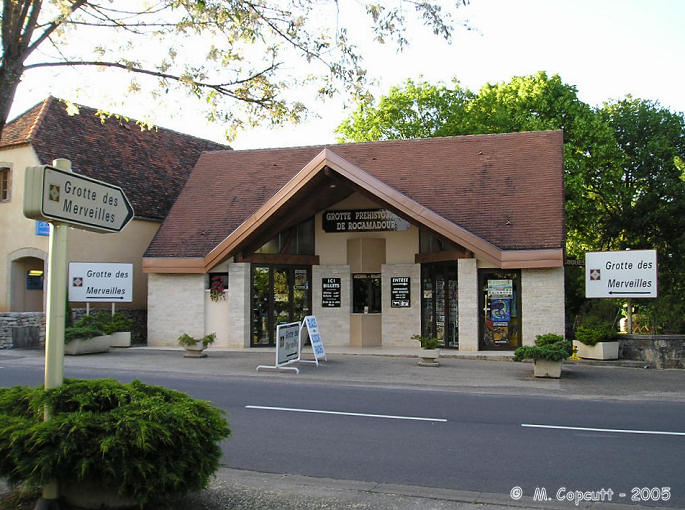<< Our Photo Pages >> Grotte des Merveilles - Cave or Rock Shelter in France in Midi:Lot (46)
Submitted by TheCaptain on Saturday, 16 April 2005 Page Views: 5430
Natural PlacesSite Name: Grotte des MerveillesCountry: France Département: Midi:Lot (46) Type: Cave or Rock Shelter
Nearest Town: Souillac Nearest Village: Rocamadour
Latitude: 44.805662N Longitude: 1.625366E
Condition:
| 5 | Perfect |
| 4 | Almost Perfect |
| 3 | Reasonable but with some damage |
| 2 | Ruined but still recognisable as an ancient site |
| 1 | Pretty much destroyed, possibly visible as crop marks |
| 0 | No data. |
| -1 | Completely destroyed |
| 5 | Superb |
| 4 | Good |
| 3 | Ordinary |
| 2 | Not Good |
| 1 | Awful |
| 0 | No data. |
| 5 | Can be driven to, probably with disabled access |
| 4 | Short walk on a footpath |
| 3 | Requiring a bit more of a walk |
| 2 | A long walk |
| 1 | In the middle of nowhere, a nightmare to find |
| 0 | No data. |
| 5 | co-ordinates taken by GPS or official recorded co-ordinates |
| 4 | co-ordinates scaled from a detailed map |
| 3 | co-ordinates scaled from a bad map |
| 2 | co-ordinates of the nearest village |
| 1 | co-ordinates of the nearest town |
| 0 | no data |
Be the first person to rate this site - see the 'Contribute!' box in the right hand menu.
Internal Links:
External Links:
I have visited· I would like to visit
TheCaptain saw from a distance on 23rd May 2005 - their rating: Access: 5 Saw the entrance to this at least the ticket office and shop. Does it have enough signs pointing to it ?

Location Source: T4T35.fr
Information:
grottedesmerveilles.com
You may be viewing yesterday's version of this page. To see the most up to date information please register for a free account.
Do not use the above information on other web sites or publications without permission of the contributor.
Nearby Images from Flickr






The above images may not be of the site on this page, but were taken nearby. They are loaded from Flickr so please click on them for image credits.
Click here to see more info for this site
Nearby sites
Click here to view sites on an interactive map of the areaKey: Red: member's photo, Blue: 3rd party photo, Yellow: other image, Green: no photo - please go there and take one, Grey: site destroyed
Download sites to:
KML (Google Earth)
GPX (GPS waypoints)
CSV (Garmin/Navman)
CSV (Excel)
To unlock full downloads you need to sign up as a Contributory Member. Otherwise downloads are limited to 50 sites.
Turn off the page maps and other distractions
Nearby sites listing. In the following links * = Image available
933m SW 225° Shrine of Rocamadour Natural Stone / Erratic / Other Natural Feature
2.3km SSW 204° Dolmen de Mages* Burial Chamber or Dolmen
2.5km N 2° Le Pouget Burial Chamber or Dolmen
3.3km NE 38° Dolmen des Plantoux Burial Chamber or Dolmen
3.5km NNE 18° Dolmen de la Rue Burial Chamber or Dolmen
3.9km NW 318° Dolmen du Pech de Gourbières 1 Burial Chamber or Dolmen
3.9km SE 145° Dolmen dit la Pierre Levée de la Pannonie Burial Chamber or Dolmen
3.9km NW 319° Dolmen du Pech de Gourbières 2 Burial Chamber or Dolmen
4.4km ESE 122° Dolmen du Pech de Grammont Burial Chamber or Dolmen
5.2km NNE 17° Dolmen des Placels Burial Chamber or Dolmen
5.7km NE 49° Dolmen du Pech 4 Burial Chamber or Dolmen
5.9km NNW 331° Dolmen des Devinaudes 1 Burial Chamber or Dolmen
5.9km NE 50° Dolmen du Pech 1* Burial Chamber or Dolmen
5.9km NNW 331° Tumulus des Devinaudes 3 Burial Chamber or Dolmen
6.0km NNW 332° Dolmen des Devinaudes 2 Burial Chamber or Dolmen
6.2km N 6° Dolmen de Pélasse Burial Chamber or Dolmen
6.2km SE 126° Dolmen des Plassous* Burial Chamber or Dolmen
6.9km NNE 22° Dolmen de Barthe Soubronne* Burial Chamber or Dolmen
7.1km NW 314° Grotte de Lacave Cave or Rock Shelter
7.5km N 10° Dolmen de Liade* Burial Chamber or Dolmen
7.9km NE 35° Dolmen de la Carture Burial Chamber or Dolmen
7.9km NE 38° Dolmen de Sabadel Burial Chamber or Dolmen
8.3km NNE 17° Dolmen de Barrade* Burial Chamber or Dolmen
8.3km N 356° La Masse Burial Chamber or Dolmen
8.4km NNE 33° Dolmen dit la Pierre Levée (Lecusses)* Burial Chamber or Dolmen
View more nearby sites and additional images






 We would like to know more about this location. Please feel free to add a brief description and any relevant information in your own language.
We would like to know more about this location. Please feel free to add a brief description and any relevant information in your own language. Wir möchten mehr über diese Stätte erfahren. Bitte zögern Sie nicht, eine kurze Beschreibung und relevante Informationen in Deutsch hinzuzufügen.
Wir möchten mehr über diese Stätte erfahren. Bitte zögern Sie nicht, eine kurze Beschreibung und relevante Informationen in Deutsch hinzuzufügen. Nous aimerions en savoir encore un peu sur les lieux. S'il vous plaît n'hesitez pas à ajouter une courte description et tous les renseignements pertinents dans votre propre langue.
Nous aimerions en savoir encore un peu sur les lieux. S'il vous plaît n'hesitez pas à ajouter une courte description et tous les renseignements pertinents dans votre propre langue. Quisieramos informarnos un poco más de las lugares. No dude en añadir una breve descripción y otros datos relevantes en su propio idioma.
Quisieramos informarnos un poco más de las lugares. No dude en añadir una breve descripción y otros datos relevantes en su propio idioma.